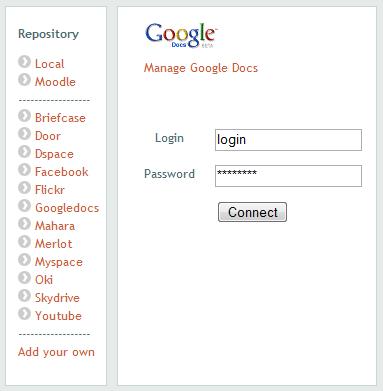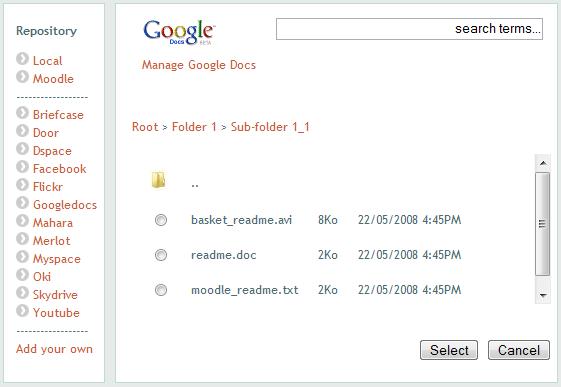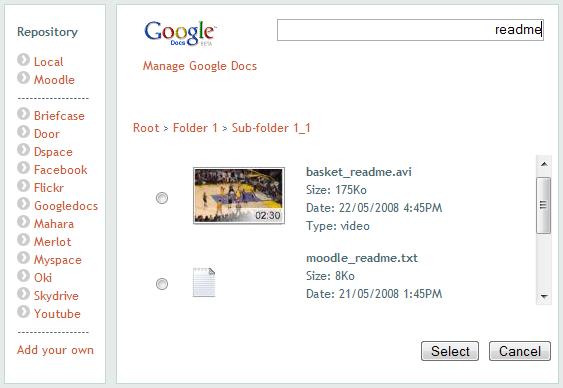Repository API
This page describes the specification for a future feature, currently being worked on for Moodle 2.0. This spec is STILL UNDER CONSTRUCTION.
See MDL-13766 to track the status of the implementation.
The page is open for everyone so everyone can help correct mistakes and help with the evolution of this document. However, if you have questions to ask, problems to report or major changes to suggest, please add them to the page comments, or start a discussion in the Repositories forum. We'll endeavour to merge all such suggestions into the main spec before we start development.
Note that parts of this document have been now split off into a separate File_API
Objectives
- Allow all Moodle users to easily bring content into Moodle from external repositories
- Provide a consistent interface to any external repository, for any Moodle module
Use cases
Teacher adding an external file as a new resource
- Teacher wants to add a new resource to a course
- Teacher clicks the "Choose a resource" button
- Teacher is presented with a simple file picker to choose a file (with a menu to switch between multiple configured repositories)
- Teacher chooses a file in an external repository
- File is COPIED into Moodle and stored by the resource module
- File is marked as owned by that user
- Whenever someone wants to view that file, the resource module controls access (see File API )
Student submitting an assignment
- Student needs to submit an assignment and presses the "Choose files" button
- Student sees a "file picker" where they can see files listed on any of several configured repositories (file picker login, file picker browser, file picker search)
- Student chooses MySpace from the list
- Student is prompted to enter MySpace username/password (if admin allows it, a checkbox could be there to "remember this for next time" but remember security)
- Student sees their files in MySpace and chooses one or more
- Files are copied from MySpace to Moodle
- Assignment module controls the permissions so that only the Student and assignment graders can see the file (other students would not have permission).
Student attaching an image to a forum
- Student needs to attach an image and presses the "Choose files" button in the posting screen
- Student sees a "file picker" where they can see files listed on any of several configured repositories
- Student chooses Mahara from the list
- Student is prompted to enter Mahara username/password
- Student sees their files in Mahara and chooses one image
- Image is copied to Moodle
- Image file is attached to forum post by Forum module (by reference)
- Forum module controls permissions so that anyone who can read that forum can see that file
Student attaching the same image in another forum
- Student needs to submit an assignment and presses the "Choose files" button
- Student sees a "file picker" where they can see files listed on any of several configured repositories
- Student chooses "Local files" from the list and sees all the files they've uploaded before
- A COPY of the image file is attached to forum post by Forum module
- Forum module controls access to this file.
Please add more use cases in this same format
Mock screenshots
When you first call up the file picker and choose a repository, you might be asked to log in (if saving of passwords is not allowed):
Browsing files could look something like this:
And you can also search:
General architecture
Each repository plugin (a standard Moodle plugin stored under /repository/xxx) will subclass the standard API and override methods specific to that repository.
As is usual in Moodle, there will be admin settings to disable/enable certain repository plugins as standard, as well as user settings so that users can add their own personal repositories to the standard list (eg Yahoo Briefcase or Google Docs) and to select their default repository.
Once a repository has been used the file will usually be copied into Moodle there and then. However there will also be options to:
- only return the URL to the file if it's desired to keep it external (but this does present security and integrity risks), or
- refresh the local file copy regularly and automatically
- refresh the file manually if desired
Once in Moodle, it is subject to the File API for access control like any other file.
Repository requirements
From the Moodle point of view, each repository is just a hierarchy of nodes.
The repository MUST provide:
- A URL to download each node (eg file).
- A list of the nodes (eg files and directories) under a given node (eg directory). This allows Moodle to construct a standard browse interface (much like a standard OS file picker). However some repository plugins may choose to completely override the repository_browse() method and implement their own interface, that's OK, as long as they end up with a URL for the file.
The repository can OPTIONALLY:
- Require some authentication credentials
- Provide more metadata about each node (mime type, size, dates, related files, dublin core stuff, etc)
- Describe a search facility (so that Moodle can construct a search form)
- Provide copyright and usage rules (or just information about the rules)
Repository plugins
Some plugins I'd like to see developed for the first version are:
- local - very similar to the current course-based file manager, except user-based
- moodle - an interface to another Moodle site, accessed over a secure mnet connection
- jsr170 - an interface that can talk to anything that supports jsr170 (eg Alfresco)
- oki - an OKI emulator allowing us to access things with OKI interfaces,like Fedora
- briefcase - an interface to Yahoo Briefcase
- myspace - an interface to MySpace files (perhaps via this MySpace API)
- googledocs - an interface to Google Docs
- skydrive - an interface to Microsoft's SkyDrive files
- facebook - an interface to Facebook files
- merlot - an interface to the learning materials in Merlot.org
- flickr - an interface to flickr
- youtube - an interface to YouTube
- mahara - an interface to a Mahara installation
- Dspace - a repository from MIT
- DOOR - another popular open source repository
- An interface for windows shares e.g. personal folders on network drives. Would need to link with LDAP as usernames will often be wholly/partially the same as network folder names. This could be done using SAMBA, but would also need to work on windows machines natively. See this block for a linux implementation.
Tables
repository
This table contains one entry for every configured external repository instance.
| Field | Type | Default | Info |
| id | int(10) | autoincrementing | |
| repositoryname | varchar | A custom name for this repository (non-unique) | |
| repositorytype | varchar | The name of the plugin being used (1 special case: "local" which covers all files uploaded from desktop) | |
| userid | int(10) | The person who created this repository instance | |
| contextid | int(10) | The context that this repository is available to ( = system context for site-wide ones) | |
| username | varchar | username to log in with, if required | |
| password | varchar | password to log in with, if required | |
| option1 | varchar | Other information useful to the plugin | |
| option2 | varchar | Other information useful to the plugin | |
| option3 | varchar | Other information useful to the plugin | |
| option4 | varchar | Other information useful to the plugin | |
| option5 | varchar | Other information useful to the plugin | |
| timecreated | int(10) | The time this repository was created | |
| timemodified | int(10) | The last time the repository was modified |
Invoking the API
Moodle moduleland code doesn't generally need to call the repository API directly. Instead it will add a moodleform item which will invoke the file picker, which in turn will call various repository plugins to create the display.
Repository plugin
Each repository plugin is required to contain the following elements:
Repository class
This class implements the interface to a particular repository, for browsing, selecting and updating files. Repositories can redefine any of these as required (and in some instances, must redefine them):
get_file($path)
Given a URL, get a file from there.
get_listing($parent='/', $search=''')
Given a path, and perhaps a search, get a listing of files.
print_login()
Show the login screen, if required
print_listing
Given a listing from get_listing, print it.
print_search
Print the search form.
store_login($username, $password, $userid=''')
If you do want to cache login details for various repositories, then use this method.
cron()
Defines operations that happen occasionally on cron.
icon.png
A logo that represents the repository


